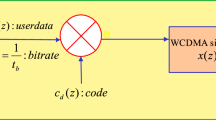Abstract
The non-orthogonal multiple access (NOMA) technology has been considered as a promising technology for the upcoming six-generation mobile communication networks (6G). However, with the increasing complexity of this access technology, how to allocate the limited network resources effectively for massive number of connectivity becomes more and more challenging. The QoE optimization problem including both the sub-channel (SC) assignment and power allocation is formulated. In order to cope with it, we first decouple it into two sub-problems: the UE-BS association, SC assignment sub-problem and the power allocation sub-problem. We thus propose genetic algorithm (GA) for UE-BS association, SC assignment and artificial bee colony (ABC) algorithm for power allocation. The corresponding constraints satisfying mechanisms are also proposed to ensure the feasibility of individual bee colony in each iteration, thus to accelerate the convergence. The simulation results show that the proposed power allocation scheme can converge to the optimal solution quickly, and the MOS can be increased by increasing the number of users (UE), and SCs.








Similar content being viewed by others
References
Baldemair R, Dahlman E, Fodor G, Mildh G, Parkvall S, Selen Y, Tullberg H, Balachandran K (2013) Evolving wireless communications: Addressing the challenges and expectations of the future. IEEE Veh Technol Mag 8(1):24–30
Dahlman E, Mildh G, Parkvall S, Peisa J, Sachs J, Selén Y, Sköld J (2014) 5g wireless access: requirements and realization. IEEE Commun Mag 52(12):42–47
Ding Z, Fan P, Poor HV (2016) Impact of user pairing on 5g nonorthogonal multiple-access downlink transmissions. IEEE Trans Veh Technol 65(8):6010–6023
Ge J, Men J (2015) Performance analysis of non-orthogonal multiple access in downlink cooperative network. IET Commun 9(18):2267–2273
Islam SMR, Avazov N, Dobre OA, Kwak K (2017) Power-domain non-orthogonal multiple access (noma) in 5g systems: Potentials and challenges. IEEE Commun Surv Tutor 19(2):721–742
Song G, Wang X, Cheng J (2017) A low-complexity multiuser coding scheme with near-capacity performance. IEEE Trans Veh Technol 66(8):6775–6786
Im G, Lee JH (2019) Outage probability for cooperative noma systems with imperfect sic in cognitive radio networks. IEEE Commun Lett 23(4):692–695
Zhang Y, Wang H-M, Zheng T-X, Yang Q (2017) Energy-efficient transmission design in non-orthogonal multiple access. IEEE Trans Veh Technol 66(3):2852–2857
Xia B, Wang J, Xiao K, Gao Y, Yao Y, Ma S (2018) Outage performance analysis for the advanced sic receiver in wireless noma systems. IEEE Trans Veh Technol 67(7):6711–6715
Dai L, Wang B, Yuan Y, Han S, Chih-lin I, Wang Z (2015) Non-orthogonal multiple access for 5g: solutions, challenges, opportunities, and future research trends. IEEE Commun Mag 53(9):74–81
Chen Z, Ding Z, Dai X, Zhang R (2017) An optimization perspective of the superiority of noma compared to conventional oma. IEEE Trans Signal Process 65(19):5191–5202
Nightingale J, Salva-Garcia P, Calero JMA, Wang Q (2018) 5g-qoe: Qoe modelling for ultra-hd video streaming in 5g networks. IEEE T BROADCAST 64(2):621–634
Fang F, Cheng J, Ding Z (2019) Joint energy efficient subchannel and power optimization for a downlink noma heterogeneous network. IEEE Trans Veh Technol 68(2):1351–1364
Bae J, Han Y (2019) Joint power and time allocation for two-way cooperative noma. IEEE Trans Veh Technol 68(12):12443–12447
Shi J, Yu W, Ni Q, Liang W, Li Z, Xiao P (2019) Energy efficient resource allocation in hybrid non-orthogonal multiple access systems. IEEE Trans Commun 67(5):3496–3511
Muhammed AJ, Ma Z, Zhang Z, Fan P, Larsson EG (2020) Energy-efficient resource allocation for noma based small cell networks with wireless backhauls. IEEE Trans Commun 68(6):3766–3781
Fu Y, Chen Y, Sung CW (2017) Distributed power control for the downlink of multi-cell noma systems. IEEE Trans Wirel Commun 16(9):6207–6220
Ali MS, Hossain E, Al-Dweik A, Kim DI (2018) Downlink power allocation for comp-noma in multi-cell networks. IEEE Trans Commun 66(9):3982–3998
Pham Q-V, Mirjalili S, Kumar N, Alazab M, Hwang W-J (2020) Whale optimization algorithm with applications to resource allocation in wireless networks. IEEE Trans Veh Technol 69(4):4285–4297
Rugelj M, Sedlar U, Volk M, Sterle J, Hajdinjak M, Kos A (2014) Novel cross-layer qoe-aware radio resource allocation algorithms in multiuser ofdma systems. IEEE Trans Commun 62(9):3196–3208
Holland JH (1992) Adaptation in Natural and Artificial Systems. MIT Press, Cambridge, MA, USA
Karaboga D, Gorkemli B, Ozturk C, Karaboga N (2014) A comprehensive survey: Artificial bee colony (abc) algorithm and applications. Artif Intell Rev 42(1):21–57
Karaboga D, Gorkemli B (2014) A quick artificial bee colony (qabc) algorithm and its performance on optimization problems. Appl Soft Comput 23:227–238
Yu W-J, Zhan Z-H, Zhang J (2018) Artificial bee colony algorithm with an adaptive greedy position update strategy. Soft Comput 22(2):437–451
Gao WF, Liu SY (2012) A modified artificial bee colony algorithm. Comput Oper Res 39(3):687–697
Zhou X, Wang H, Wang M, Wan J (2015) Enhancing the modified artificial bee colony algorithm with neighborhood search. Soft Comput 21(10):1–11
Acknowledgements
This work was supported in part by the Major Scientific and Technological Innovation Project of Shandong Province under Grant No. 2019JZZY010128, in part by the National Natural Science Foundation of China under Grants No. 61772126, 61972079, and 62172084, in part by the Fundamental Research Funds for the Central Universities under Grants N2016004, N2016002, N2116004, N2116009, and N2024005-1, in part by the Central Government Guided Local Science and Technology Development Fund Project under Grant 2020ZY0003, in part by the Science and Technology Plan Project of Inner Mongolia Autonomous Region of China under Grant 2020GG0189, in part by the LiaoNing Revitalization Talents Program under Grant No. XLYC2007162, in part by the Young and Middle-aged Scientific and Technological Innovation Talent Support Program of Shenyang under Grant RC200548.
Author information
Authors and Affiliations
Corresponding author
Additional information
Publisher’s Note
Springer Nature remains neutral with regard to jurisdictional claims in published maps and institutional affiliations.
Rights and permissions
About this article
Cite this article
Jia, J., Xu, Y., Du, Z. et al. Joint resource allocation for QoE optimization in large-scale NOMA-enabled multi-cell networks. Peer-to-Peer Netw. Appl. 15, 689–702 (2022). https://doi.org/10.1007/s12083-021-01270-8
Received:
Accepted:
Published:
Issue Date:
DOI: https://doi.org/10.1007/s12083-021-01270-8




